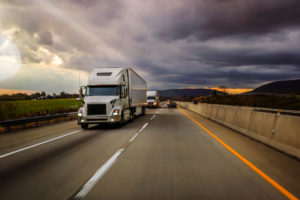By Jacob Biba, Builtin
Autonomous trucking is a term used to describe self-driving tractor trailers that transport goods. The aim of autonomous trucking is to one day get big rigs and delivery trucks, and the things they carry, from point A to point B without human intervention. Today, autonomous trucks are traveling on roadways in various parts of the United States, like the Southwest, at a limited capacity, often with a safety driver on board to take control if anything were to go haywire.
Autonomous Truck Companies to Know
- Einride
- Embark
- Gatik
- Kodiak Robotics
- TuSimple
- Waabi
- Waymo
How Do Autonomous Trucks Work?
Autonomous trucks work by using sensing technologies like LiDAR (a sensing technology that uses light to determine distance), radar and optical cameras to gather visual data from the surrounding area, delivering that information to a computer loaded with maps and algorithms that analyzes the information and makes decisions. It’s not too different from how a brain uses what a human eye feeds it to decide when it’s safe to change lanes or make a left turn.
Like other self-driving vehicles, software is the key to autonomous trucking. As a result, most autonomous truck companies aren’t actually manufacturing trucks, they’re writing the code that integrates artificial intelligence with all the sensors, maps, algorithms and other perception tools needed for trucks to forgo human drivers.
“We don’t build the trucks … We make software, and then we have a set of modules that we call Embark Universal Interface that allow a variety of different types of platforms to run that software.”
“We don’t build the trucks,” Alex Rodrigues, CEO and co-founder of Embark, an autonomous truck company based in San Francisco, California, told Built In. “We make software, and then we have a set of modules that we call Embark Universal Interface that allow a variety of different types of platforms to run that software.”
According to Rodrigues, Embark’s software works by breaking down the individual actions required to operate a big rig into steps related to perception, planning, control and vehicle actuation, just like a human driver would.
When Will Autonomous Trucks Be a Reality?
Autonomous trucks are a reality — but they’re not the norm.
“It was assumed that long haul trucking would be the first autonomous delivery use case to commercialize, and it since proved out that it’s somewhat more challenging than was originally expected,” Richard Steiner, head of policy and communications at Gatik, an autonomous truck company focused on middle-mile deliveries between businesses, told Built In.
But Steiner believes autonomous trucking will ultimately become more prevalent — it’s just a few years away.
Over the course of the next few years, companies will have to overcome barriers, like regulation, that are holding the industry back, according to Ann Campbell, a professor of business analytics at University of Iowa’s Tippie College of Business.
Getting On and Off Highways
One barrier is related to how autonomous trucks will get on and off highways and how they’ll operate in points of origin, like a port, if they’re going to be fully autonomous, Campbell said. (The most likely solution would be for a human driver to operate the truck in those situations.)
Road Conditions
And then there’s weather and other unforeseen events that happen on highways, like accidents.
“I think that’s where you get the win, is when you’re on the highway and everything’s in good condition,” Campbell said. “But you still probably need what they call a safety driver, at least in some of the trucks, to handle those strange situations.”
Regulations
Additionally, there’s regulators to think about.
In the United States, more than half the states allow autonomous trucks, but some don’t, making long haul transport difficult.
“If you’re going coast to coast, you may have to encounter a state that doesn’t allow for autonomous vehicles, so you have to go all the way around it,” Steiner said. “There’s a challenge there.”
With autonomous trucks navigating much shorter routes ranging anywhere between a few miles and 300 miles, Gatik has had an easier time overcoming regulatory obstacles, which has put the company in a strong position for growth, according to Steiner.
“Just speaking to our use case — hyper-constrained, structured, point-to-point, fixed, known, repeatable routes — that language has resonated very well with regulators who said, ‘OK, this makes sense to us from a safety framework,’” Steiner said.
‘A Dimmer Switch’
Rodrigues said Embark is aiming for 2024, with a slow deployment — he describes it more as a dimmer switch than a light switch — primarily in the Sunbelt states. “If you’re living in Chicago you’re not going to see self-driving trucks in 2024,” he said, noting the limits on scalability, regulations and ease of use. “But in Phoenix, we might start to see that.”
Embark is also focusing on working with customers to make their system more user friendly and production ready. “There’s a whole lot of work to go from ‘it drives itself’ to ‘it drives itself and we can deliver them at scale and you can turn them on and they just work,’” Rodrigues said.
Will Autonomous Trucks Replace Drivers?
To some degree, autonomous trucks could replace drivers, but there’s already a sizable shortage in the labor market, which is constraining the supply chain as it is. Instead, Rodrigues and others like Campbell see autonomous trucks as improving the quality of life of drivers and making the job more enjoyable.
“Being able to take out that road part and just have the drivers do the part where their technique and skill is really involved could make it a much more interesting job for people,” Campbell said.
“So, you have a pool of drivers who want to be able to work in one city, but then you have a pool of actual routes that are unfilled, that are these long intercity routes … And what we’re able to do is pair those together, where you have the driverless truck do the ferrying across those long distances.”
Because Embark’s self-driving platform is designed for autonomous highway driving — not city centers — Rodrigues believes drivers will be able to work locally in a single city transporting trucks to and from highways, while Embark’s autonomous system guides the truck between those cities.
“So, you have a pool of drivers who want to be able to work in one city, but then you have a pool of actual routes that are unfilled, that are these long intercity routes,” Rodrigues said. “And what we’re able to do is pair those together, where you have the driverless truck do the ferrying across those long distances.”
Will Autonomous Trucks Replace Air Freight?
Autonomous truck companies frequently tout the benefits of self-driving trucks, from increasing efficiency in the logistics industry to cutting transport costs.
“If you look over the next decade, trucking is, fairly obviously, the market that’s going to create the most value for self driving because it solves a really pressing problem in terms of drivers not wanting to be out on the road for long periods of time,” Rodrigues said. “In terms of moving valuable loads 24 hours a day, you get a lot more utilization and you’re solving a real problem.”
As a result, autonomous trucking has the potential to rival air freight, according to Campbell.
“This idea of going to autonomous trucking could really speed up the supply chain so much for a lot of products, that could start to make trucking be really competitive with air freight in a way we’ve never seen,” Campbell told Built In. “And that could have a big impact.”
Essentially, what would normally take several days to transport goods with a human driver, given federal regulations limiting driving time to 11 hours, could be done in as little as one day with an autonomous truck running continuously, stopping only to refuel or for inspections. As a result, companies relying on shipments could adjust the amount of inventory they receive in one shipment and could have smaller warehouses, Campbell said, all of which would reduce operating costs for businesses.
Autonomous Trucking Companies
When it comes to a driverless future in the trucking industry, these autonomous truck companies appear to be in it for the long haul.
Einride is an autonomous truck company based in Stockholm, Sweden. The company’s trucks are electric and operate in the United States and in Europe. Einride secured an additional $500 million in financing last year and was the first company to be approved to operate one of its trucks without a safety driver on a public road in the United States, according to Robotics and Automation News. It conducted its first test run in October.
Kodiak is an autonomous truck company headquartered in Mountain View, California, and began transporting goods in 2019. Its trucks operate in the southern portion of the United States and the company’s 2,500th delivery was made in 2022, according to FreightWaves, a trade publication focused on the supply chain. The same year, one of the company’s trucks completed a 5,600 mile freight run from San Antonio, Texas to San Francisco, California, and then Jacksonville, Florida, before returning to San Antonio, according to TechCrunch. The trip, which was for a private mail carrier for the United States Postal Service, took 114 hours to complete. Also in 2022, Kodiak was awarded a $49.9 million contract to help develop combat vehicles for the U.S. Army, CNBC reported.
TuSimple is an autonomous truck company based in San Diego. Founded in 2015, the company operates in the southwest and southeast regions of the United States, using terminals within its Autonomous Freight Network in cities like Phoenix, Dallas and Orlando. Currently, the company’s trucks operate with a safety driver onboard, but according to its website, in December 2021, one of TuSimple’s trucks operated on a public roadway without a safety driver onboard “while naturally interacting with other motorists.”
Headquartered in Toronto, Canada, Waabi is a relatively new autonomous truck company founded in 2021. Last year, the company released its first self-driving truck which relies on Waabi Driver, the company’s software designed to be integrated during the truck’s manufacturing stage. According to TechCrunch, Waabi’s first run of trucks will be used for commercial pilots and testing.
Waymo is a self-driving technology company born out of Google’s autonomous vehicle project. Through Waymo Via, the company is integrating its self-driving platform, Waymo Driver, to the trucking industry. The company is currently testing autonomous trucks in New Mexico, California, Texas and Arizona.

